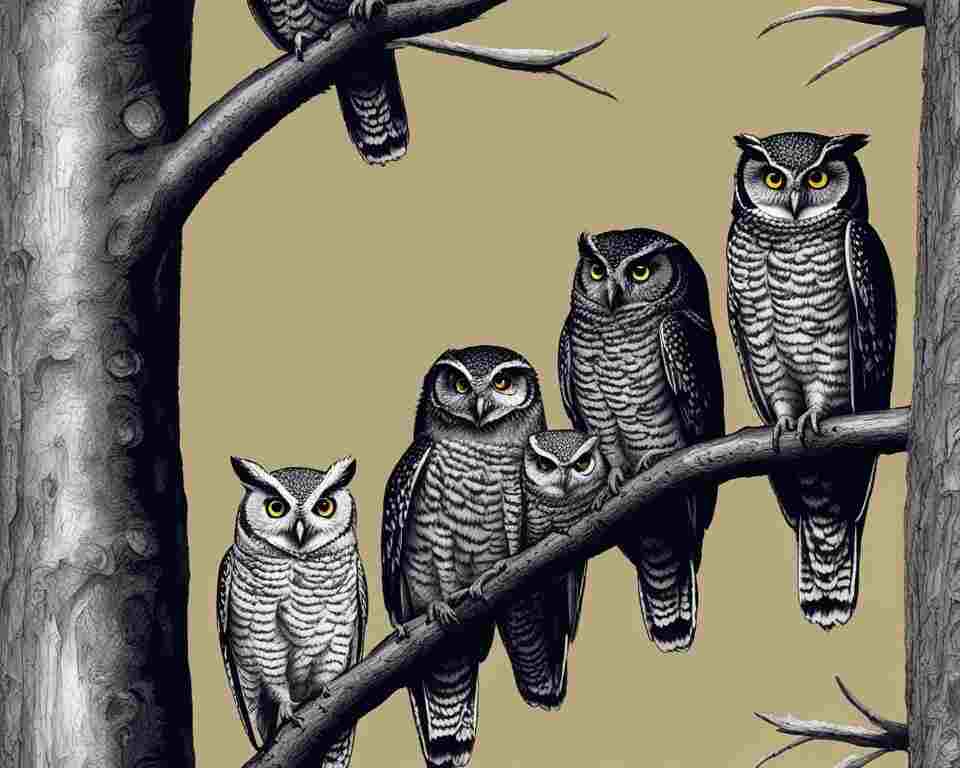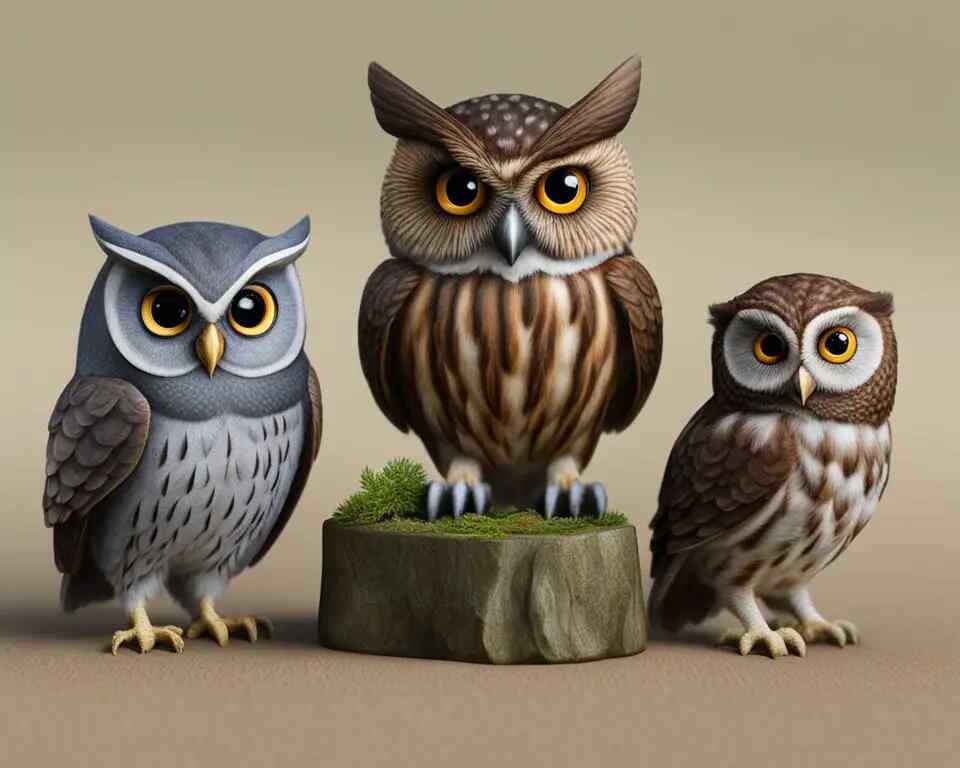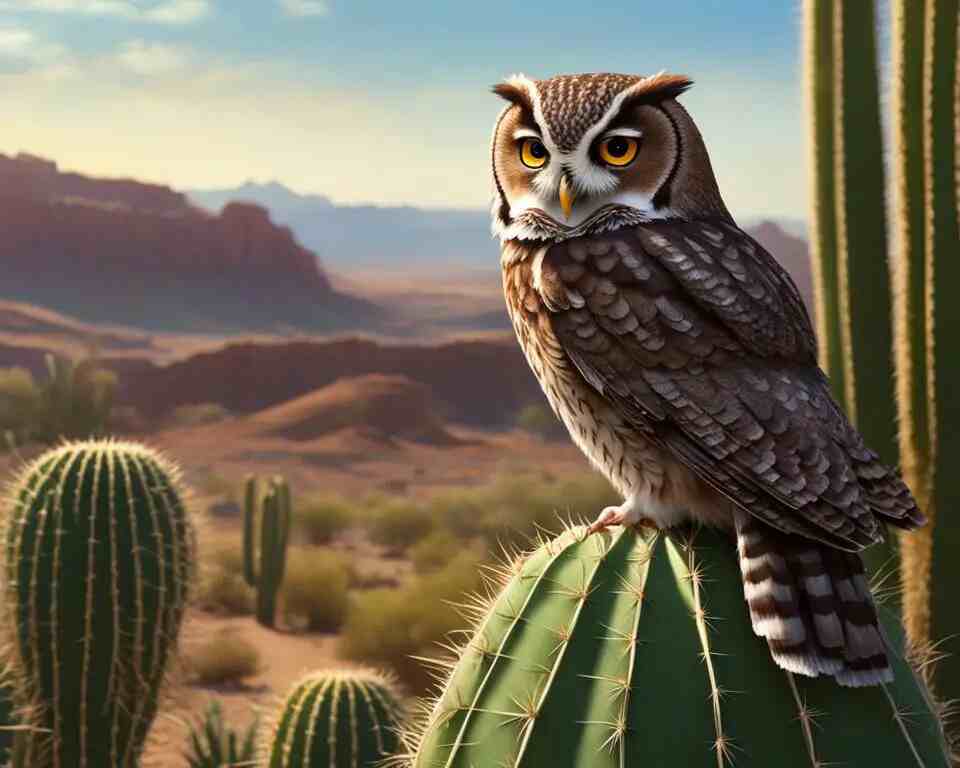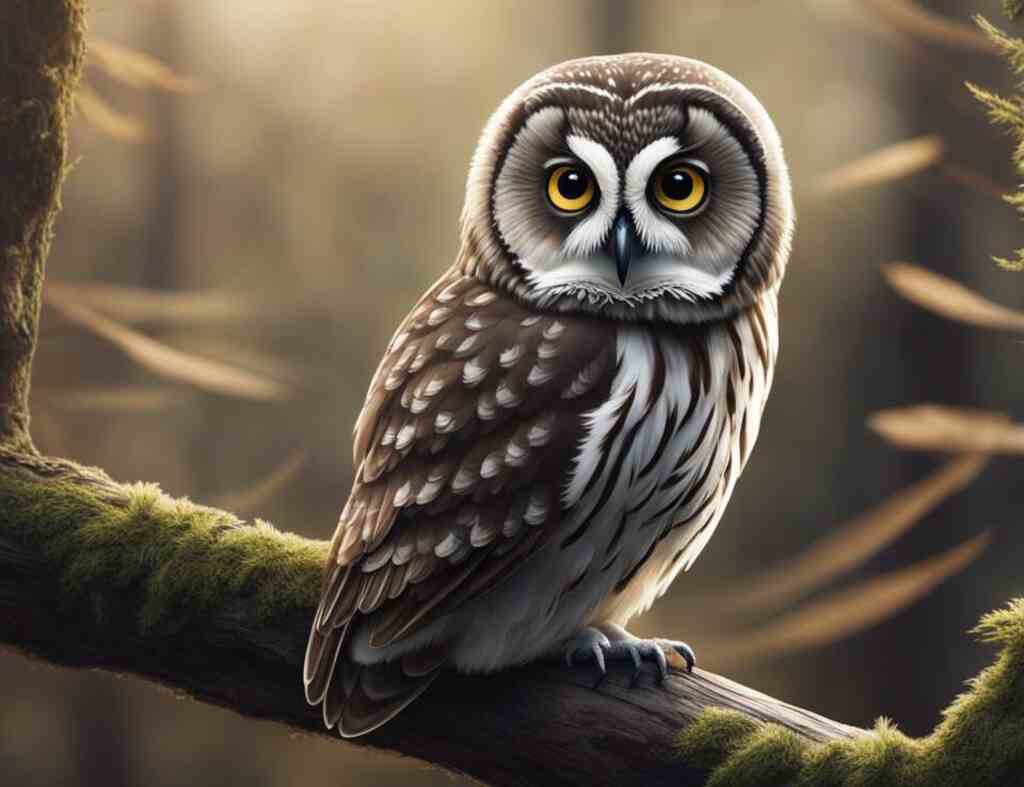In this article, we invite you to explore the fascinating world of owls in North America. Today, we are focusing on the Elf Owl, which holds title of the smallest owl species not just in this region, but in the entire world.
With its diminutive size and captivating features, the Elf Owl has captured the hearts of bird enthusiasts and wildlife lovers alike.
Table of Contents
Key Takeaways:
- The Elf Owl is the smallest owl species in North America, and the world measuring less than six inches in height and weighing less than an ounce and a half.
- It is distinguishable by its gray feathers, big yellow eyes, and its determined hunting behavior.
- The Elf Owl can be found in woodlands and desert cactus habitats of southwest Texas, southern Arizona, and New Mexico.
- Its diet consists of beetles, crickets, spiders, and occasionally lizards or mice.
- Conservation efforts play a crucial role in protecting the Elf Owl’s habitat and ensuring the preservation of North American owl populations.

What is the Smallest Owl in North America?
The smallest owl in North America is the Elf Owl (Micrathene whitneyi). It measures about the size of a sparrow, usually around 5 to 6 inches (13 to 15 centimeters) in length and has a wingspan of about 9 to 10 inches (23 to 25 centimeters). The Elf Owl is known for its diminutive size and is found in the southwestern United States and parts of Mexico, often inhabiting desert regions with saguaro cacti and mesquite trees.
Small Owl Species in North America
North America is home to a variety of small owl species. These tiny owls add charm and diversity to the avian population in the region. Here, we introduce you to some of the small owl species that measure under a foot in length. From the iconic Boreal Owl to the adorable Burrowing Owl, each species has its own unique characteristics.
The Boreal Owl
The Boreal Owl is known for its round face and piercing yellow eyes. It is a small owl species, measuring around 9.5 to 11 inches in length. These owls can be found in the boreal forests of North America, including parts of Canada, Alaska, and the northern United States.
The Burrowing Owl
The Burrowing Owl is a pint-sized owl that is often found nesting in burrows dug by ground squirrels or prairie dogs. These owls are about 8 to 11 inches in length and have long legs. They are commonly spotted in grasslands and desert regions of North America.
The Western Screech Owl
The Western Screech Owl is a small owl species that can be found in forests, woodlands, and even urban areas across western North America. These owls are typically around 8.5 to 10 inches in length and have a range of color variations, from gray to brown.
The Eastern Screech Owl
The Eastern Screech Owl is a close relative of the Western Screech Owl but is found in the eastern parts of North America. These owls are similar in size, measuring around 8.5 to 10 inches. They are known for their distinctive ear tufts and can be gray or reddish-brown in color.
| Owl Species | Size (inches) | Habitat |
|---|---|---|
| Boreal Owl | 9.5 – 11 | Boreal forests |
| Burrowing Owl | 8 – 11 | Grasslands, deserts |
| Western Screech Owl | 8.5 – 10 | Forests, woodlands, urban areas |
| Eastern Screech Owl | 8.5 – 10 | Forests, woodlands, urban areas |
These are just a few examples of the small owl species that call North America home. From the Northern Saw-Whet Owl to the Whiskered Screech Owl, each species has its own unique characteristics and habitats. Exploring the world of small owls is a fascinating journey that showcases the beauty and diversity of these magnificent creatures.
Characteristics and Behavior of the Elf Owl
When it comes to owl species size, the Elf Owl is undeniably the smallest in North America. Measuring less than six inches in length and weighing less than an ounce and a half, it is truly a remarkable creature. Its small size and distinctive features make it easily recognizable, with gray feathers and big yellow eyes that captivate anyone fortunate enough to spot one.
Despite its diminutive stature, the Elf Owl is a determined predator. It preys on beetles, crickets, spiders, and occasionally lizards or mice. Its hunting prowess is remarkable, considering its tiny size. The Elf Owl showcases the remarkable adaptations and behaviors of small owl species, proving that size does not dictate effectiveness as a predator.
In terms of owl size comparison, the Elf Owl stands out among its larger counterparts. While other owl species may tower over it, the Elf Owl holds its own with its impressive survival skills and ability to thrive in its habitat. Its small size also allows it to utilize unique hunting and nesting opportunities that may not be accessible to larger owls.

Owl Size Chart
| Owl Species | Average Length | Average Weight |
|---|---|---|
| Elf Owl | Less than 6 inches | Less than 1.5 ounces |
| Boreal Owl | 9.1 inches | 3.5 ounces |
| Burrowing Owl | 8.5 inches | 5.3 ounces |
| Western Screech Owl | 9.1 inches | 5.3 ounces |
| Eastern Screech Owl | 8.5 inches | 5.3 ounces |
As seen in the owl size chart, the Elf Owl is considerably smaller than other species such as the Boreal Owl, Burrowing Owl, Western Screech Owl, and Eastern Screech Owl. However, it still holds its own in the diverse world of owl species, providing us with valuable insights into the unique adaptations and behaviors of these magnificent creatures.
Habitat and Range of the Elf Owl
The Elf Owl is primarily found in woodlands and desert cactus habitats in southwest Texas, southern Arizona, and New Mexico. It is a versatile species that can adapt to different environments within these regions. The Elf Owl prefers areas with trees, as it uses tree cavities for nesting purposes. However, it can also be found nesting in the cavities of saguaro cacti, which provide suitable shelter.
The restricted range of the Elf Owl contributes to the diversity of owl species in North America. While it is not found in other parts of the continent, its presence in specific regions adds to the overall variety of bird species in the area. This reinforces the importance of preserving and protecting the habitats where the Elf Owl resides.
Table: Comparison of North American Owl Species
| Owl Species | Size | Habitat | Range |
|---|---|---|---|
| Elf Owl | Less than 6 inches | Woodlands and desert cactus habitats | Southwest Texas, southern Arizona, and New Mexico |
| Great Horned Owl | 18-25 inches | Various habitats including forests, deserts, and urban areas | Throughout North America |
| Snowy Owl | 20-28 inches | Tundra and Arctic regions | Northern parts of North America |
| Burrowing Owl | 9.8-11 inches | Open grasslands and prairies | Throughout North and Central America |
As shown in the table above, the Elf Owl stands out for its small size compared to other North American owl species. This highlights the diversity of owls native to North America, with each species adapted to different habitats and ranges.
Hunting and Diet of the Elf Owl
When it comes to owl behavior, the Elf Owl is a truly remarkable species. Despite being the smallest owl in North America, it exhibits impressive hunting skills and a diverse diet. The Elf Owl is primarily active during dusk and dawn, making it a crepuscular predator. Its small size and agile flight allow it to navigate through woodlands and desert cactus habitats with ease, searching for its prey.
The diet of the Elf Owl consists of a wide range of creatures. Its main food sources include beetles, crickets, and spiders. However, the Elf Owl is not limited to insects, as it occasionally hunts lizards or mice. This adaptable diet ensures the owl’s survival and contributes to the delicate balance of North American owl populations.
| Owl Behavior | Owl Identification | Owl Facts | North American Owl Populations |
|---|---|---|---|
| The Elf Owl exhibits crepuscular behavior, hunting primarily at dusk and dawn. | Despite its small size, the Elf Owl can be easily identified by its gray feathers and large yellow eyes. | The Elf Owl is the smallest owl species in North America, measuring less than six inches tall and weighing less than an ounce and a half. | The Elf Owl is a part of the diverse owl populations found in North America. |
Through its hunting behavior and diverse diet, the Elf Owl plays a crucial role in the ecosystem. It helps to control insect populations, ensuring the balance of the food chain. Additionally, the ability of the Elf Owl to catch its prey with precision and agility showcases the remarkable adaptations of these fascinating nocturnal creatures.
Overall, the hunting and diet of the Elf Owl provide insights into the behavior and ecological significance of North American owl species. By understanding these aspects, we can better appreciate the intricate web of life and the importance of preserving the habitats that support these remarkable small owls.

Conservation of the Elf Owl
The conservation of the Elf Owl is a crucial endeavor in preserving the diverse populations of North American owls. As one of the smallest owl species in North America, the Elf Owl faces unique challenges that require focused conservation efforts. Its small size and specific habitat requirements make it particularly vulnerable to habitat loss and degradation.
To ensure the survival of the Elf Owl and other owl species in the United States, it is essential to protect and restore their woodland and desert cactus habitats. By safeguarding these habitats, we can provide nesting sites and hunting grounds for these small owls, allowing them to thrive in their natural environments.
Threats to North American Owl Populations
The Elf Owl is just one of the many owl species that call North America home. However, the populations of these magnificent creatures are under constant threat due to various factors such as habitat destruction, climate change, and human activities.
The rapid urbanization and expansion of human settlements have resulted in the loss and fragmentation of owl habitats, making it challenging for these birds to find suitable places to nest and hunt.
Additionally, the use of pesticides and other harmful chemicals in agriculture poses a significant risk to owl populations and their prey.
As owls are at the top of the food chain, they can be exposed to high levels of toxins through the organisms they consume, leading to adverse health effects and population declines.
Importance of Wildlife Conservation
Protecting owl populations is not only essential for the survival of these remarkable birds but also crucial for maintaining the balance of ecosystems. Owls play a vital role in controlling rodent populations, helping to prevent agricultural damage and maintain healthy ecosystems.
By conserving and enhancing owl habitats, we can promote biodiversity and preserve the delicate interconnections between different species.
Furthermore, the conservation of owl populations aligns with broader wildlife conservation efforts. By safeguarding the habitats and populations of these fascinating creatures, we contribute to the preservation of overall bird populations and the rich tapestry of nature that sustains us all.
| Owl Species | Average Size (inches) |
|---|---|
| Elf Owl | Less than 6 |
| Boreal Owl | 9-11 |
| Burrowing Owl | 9.8-11.8 |
| Western Screech Owl | 8-10 |
| Eastern Screech Owl | 7-10 |
| Northern Saw-Whet Owl | 7-8.5 |
| Whiskered Screech Owl | 8-8.5 |
| Northern Pygmy Owl | 6.3-7 |
| Ferruginous Pygmy Owl | 6.7-7.3 |
| Flammulated Owl | 6.9-7.5 |
| Mountain Pygmy Owl | 7-7.4 |
Conclusion
The Elf Owl is truly a fascinating and unique species that showcases the incredible adaptations and behaviors of nocturnal birds. As the smallest owl in North America, it captivates our hearts with its charming size and distinctive features. By understanding and appreciating the Elf Owl, we gain a deeper appreciation for the diverse wildlife that inhabits our continent.
As nature enthusiasts, it is our responsibility to advocate for wildlife conservation and protect the habitats of these remarkable creatures. The Elf Owl, like many other owls, plays a vital role in maintaining the balance of ecosystems. They help control populations of insects and small mammals, contributing to the overall health and biodiversity of our environment.
By supporting conservation efforts and raising awareness about the importance of protecting our natural resources, we can ensure a brighter future for the Elf Owl and other endangered species. From the charming owlet to the majestic nocturnal birds, let us continue to admire and respect the wonders of nature and work together to preserve them for generations to come.
FAQs
What is the size of the Elf Owl?
The Elf Owl is the smallest owl species in North America, measuring less than six inches tall.
Where can the Elf Owl be found?
The Elf Owl can be found in woodlands and desert cactus habitats in southwest Texas, southern Arizona, and New Mexico.
What does the Elf Owl eat?
The Elf Owl primarily hunts beetles, crickets, spiders, and occasionally lizards or mice.
Does the Elf Owl migrate?
Yes, during the winter, the Elf Owl migrates to Mexico and returns to the US in late February or March for its breeding season.
What are the other small owl species in North America?
The other small owl species in North America include the Boreal Owl, Burrowing Owl, Western Screech Owl, Eastern Screech Owl, Northern Saw-Whet Owl, Whiskered Screech Owl, Northern Pygmy Owl, Ferruginous Pygmy Owl, Flammulated Owl, Mountain Pygmy Owl.
Why is the conservation of the Elf Owl important?
The Elf Owl faces unique conservation challenges due to its small size and specific habitat requirements. Conservation efforts focus on protecting and restoring its woodland and desert cactus habitats to preserve North American owl populations and biodiversity.


